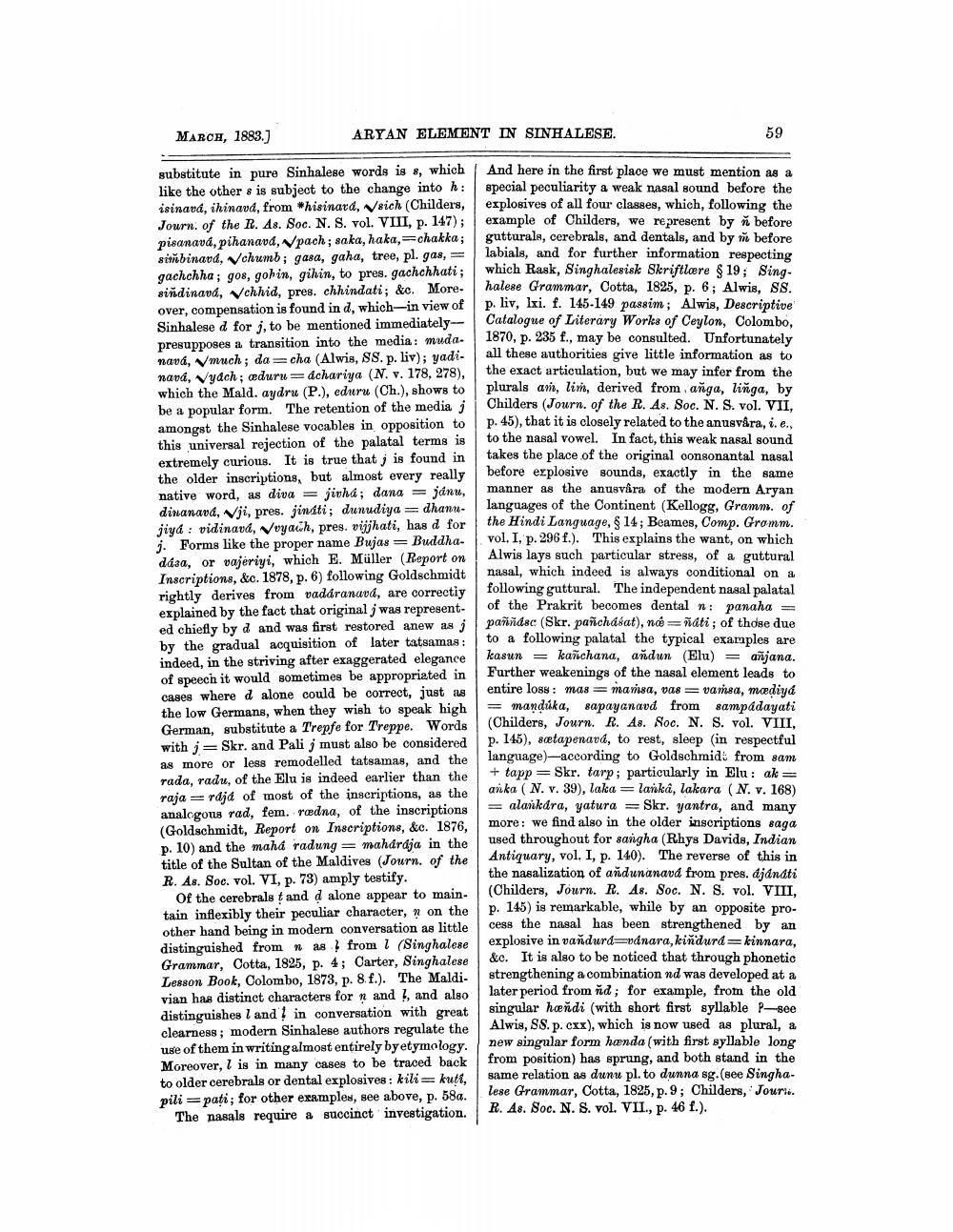________________
MARCH, 1883.)
ARYAN ELEMENT IN SINHALESE.
59
substitute in pure Sinhalese words is , which like the other & is subject to the change into h: isinara, ihinaud, from hisinard, sich (Childers, Journ of the R. 48. Soc. N. S. vol. VIII, p. 147); pisanavd, pihanavd, pach; saka, haka,=chakka; sitñbinavd, chumb; gasa, gaha, tree, pl. gas, gachchha; gos, gohin, gihin, to pres. gachchhati; siñdinand, chhid, pres. chhindati; &c. More. over, compensation is found in d, which-in view of Sinhalese d for j, to be mentioned immediately
had immediately- presupposes a transition into the media: mudanavá, much; da=cha (Alwis, SS. p. liv); yadi. navá, Vydch; æduru=dchariya (N. v. 178, 278), which the Mald. aydru (P.), eduru (Ch.), shows to be a popular form. The retention of the media j amongst the Sinhalese vocables in opposition to this universal rejection of the palatal terms is extremely curious. It is true that is found in the older inscriptions, but almost every really native word, as diva = jivha; dana = janu, dinanava, vji, pres. jináti; dunudiya = dhanu. jiya : vidinavá, Voyach, pres. vijjhati, has d for 3. Forms like the proper name Bujas = Buddha. dása, or vajeriyi, which E. Müller (Report on Inscriptions, &c. 1878, p. 6) following Goldschmidt rightly derives from vadáranaud, are correctiy explained by the fact that original j was represent. ed chiefly by d and was first restored anew as j by the gradual acquisition of later tatsamas: indeed, in the striving after exaggerated elegance of speech it would sometimes be appropriated in cases where d alone could be correct, just as the low Germans, when they wish to speak high German, substitute a Trepfe for Treppe. Words with j = Skr. and Pali j must also be considered
and Pali i must also be considered as more or less remodelled tatsamas, and the rada, radu, of the Elu is indeed earlier than the raja =rdjd of most of the inscriptions, as the analogous rad, fem. redna, of the inscriptions (Goldschmidt, Report on Inscriptions, &c. 1876, p. 10) and the maha radung = maharaja in the title of the Sultan of the Maldives (Journ. of the R. As. Soc. vol. VI, p. 73) amply testify.
Of the cerebrals and d alone appear to maintain inflexibly their peculiar character, on the other hand being in modern conversation as little distinguished from as? from 1 (Singhalese Grammar, Cotta, 1825, p. 4; Carter, Singhalese Lesson Book, Colombo, 1873, p. 8. f.). The Maldivian has distinct characters for n and !, and also distinguishes 1 and ! in conversation with great clearness; modern Sinhalese authors regulate the use of them in writing almost entirely by etymology. Moreover, 1 is in many cases to be traced back to older cerebrals or dental explosives: kili= kutí, pili=pați; for other examples, see above, p. 58a.
The nasals require a succinct investigation.
And here in the first place we must mention as a special peculiarity a weak nasal sound before the explosives of all four classes, which, following the example of Childers, we represent by v before gutturale, cerebrals, and dentals, and by it before labials, and for further information respecting which Rask, Singhalesisk Skriftlære $ 19; Singhalese Grammar, Cotta, 1825, p. 6; Alwis, SS. p. liv, lxi. f. 145-149 passim; Alwis. Descriptive Catalogue of Literary Works of Ceylon, Colombo, 1870, p. 235 f., may be consulted. Unfortunately all these authorities give little information as to the exact articulation, but we may infer from the plurals ano, lin, derived from anga, linga. by Childers (Journ. of the R. As. Soc. N. S. vol. VII, p. 45), that it is closely related to the anusvåra, i.e.. to the nasal vowel. In fact, this weak nasal sound takes the place of the original consonantal nasal before explosive sounds, exactly in the same manner as the anusvåra of the modern Aryan languages of the Continent (Kellogg, Gramn. of the Hindi Language, $ 14; Beames, Comp. Gromm. vol. I, p. 296 f.). This explains the want, on which Alwis lays such particular stress, of a guttural nasal, which indeed is always conditional on a following guttural. The independent nasal palatal of the Prakrit becomes dental n: panaha = pañidsc (Skr. pañchasat), nde=ñati; of those due to a following palatal the typical examples are kasun = kañchana, andun (Elu) = añjana. Further weakenings of the nasal element leads to entire loss: mas = mansa, vas = varsa, mædiya = mandúka, sapayanand from sampadavati (Childers, Journ. R. As. Soc. N. S. vol. VIII, p. 145), stapenavá, to rest, sleep in respectful language)-according to Goldschmidfrom sam + tapp=Skr, tarp; particularly in Elu: ak = aika (N. v. 39), laka = lanka, lakara (N. v. 168) =alankdra, yatura =Skr. yantra, and many more: we find also in the older inscriptions saga used throughout for sangha (Rhys Davids, Indian Antiquary, vol. I, p. 140). The reverse of this in the nasalization of añdunanard from pres. djandti (Childers, Journ. R. As. Soc. N. S. vol. VIII, p. 145) is remarkable, while by an opposite process the nasal has been strengthened by an explosive in vardurd=ndnara, kiñdurd=kinnara, &c. It is also to be noticed that through phonetic strengthening a combination nd was developed at a later period from ñd; for example, from the old singular hæñdi (with short first syllable p-see Alwis, SS.p. cxx), which is now used as plural, a new singular form hænda (with first syllable long from position) has sprung, and both stand in the same relation as dunu pl. to dunna sg.(see Singhalese Grammar, Cotta, 1825, p. 9; Childers, Jouri. R. 48. Soc. N. S. vol. VII., p. 46 f.).




